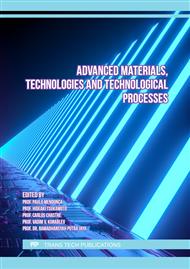p.3
p.11
p.19
p.29
p.35
p.41
p.49
p.55
Effect of Selective Laser Melting Parameters on Physicomechanical Properties of Ferromagnetic Shape Memory Ni36Al27Co37 Alloy
Abstract:
In this work Ni36Al27Co37 ferromagnetic shape memory alloy was studied. Selective laser melting (SLM) was carried out at the modes providing the volumetric energy density (VED) of 70-200 J/mm3. It was shown that in order to obtain dense samples, VED should be at least 90 J/mm3 for this alloy. The maximum density was achieved at 150 J/mm3.With an increase in VED, the hardness nonlinearly decreases from 447 HV to 413 HV. The samples without visible defects showed a mean conventional tensile failure stress of 479 MPa and a residual deformation of about 0.04%, which confirms their brittleness when not heat-treated.Investigation into crystallographic structure of Ni36Al27Co37 SLM-samples showed that the laser power, scanning speed and hatch distance effects should not be considered separately but in complex. It was found that the most promising approach to obtain anisotropy in this alloy is a simultaneous decrease in the hatch distance and an increase in the scanning speed. In this case, the crystallites aspect ratio achieves values of up to 12 that makes the alloy prospective to show high magnetically induced strain.
Info:
Periodical:
Pages:
11-17
Citation:
Online since:
March 2023
Price:
Сopyright:
© 2023 Trans Tech Publications Ltd. All Rights Reserved
Share:
Citation:


